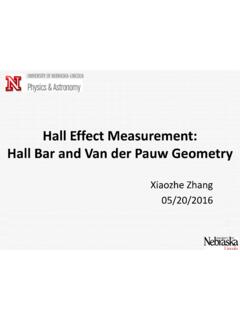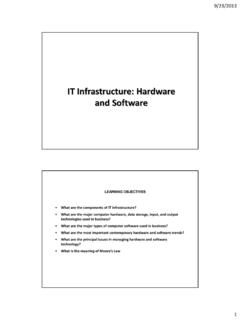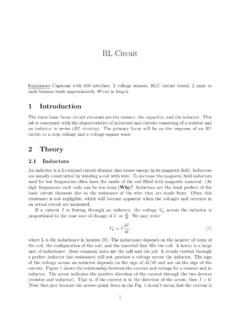Transcription of Electric and Magnetic Forces
1 Electric and Magnetic Forces263 Electric and Magnetic ForcesElectromagnetic Forces determine all essential features of charged particle acceleration andtransport. This chapter reviews basic properties of electromagnetic Forces . Advanced topics, suchas particle motion with time-varying Forces , are introduced throughout the book as they is convenient to divide Forces between charged particles into Electric and magneticcomponents. The relativistic theory of electrodynamics shows that these are manifestations of asingle force. The division into Electric and Magnetic interactions depends on the frame ofreference in which particles are introduces electromagnetic Forces by considering the mutual interactions betweenpairs of stationary charges and current elements.
2 Coulomb's law and the law of Biot and Savartdescribe the Forces . Stationary charges interact through the Electric force. Charges in motionconstitute currents. When currents are present, Magnetic Forces also electrodynamics is described completely by the summation of Forces betweenindividual particles, it is advantageous to adopt the concept of fields. Fields (Section ) aremathematical constructs. They summarize the Forces that could act on a test charge in a regionwith a specified distribution of other charges. Fields characterize the electrodynamic properties ofthe charge distribution.
3 The Maxwell equations (Section ) are direct relations between electricand Magnetic fields. The equations determine how fields arise from distributed charge and currentand specify how field components are related to each and Magnetic Forces27F(1Y2)'14 oq1q2urr2(newtons).( ) o' 10&12(A&s/V&m). Electric and Magnetic fields are often visualized as vector lines since they obey equations similarto those that describe the flow of a fluid. The field magnitude (or strength) determines the densityof tines. In this interpretation, the Maxwell equations are fluidlike equations that describe thecreation and flow of field lines.
4 Although it is unnecessary to assume the physical existenceof field lines, the concept is a powerful aid to intuit complex Lorentz law (Section ) describes electromagnetic Forces on a particle as a function offields and properties of the test particle (charge, position and velocity). The Lorentz force is thebasis for all orbit calculations in this book. Two useful subsidiary functions of field quantities, theelectrostatic and vector potentials, are discussed in Section The electrostatic potential (afunction of position) has a clear physical interpretation.
5 If a particle moves in a static Electric field,the change in kinetic energy is equal to its charge multiplied by the change in electrostaticpotential. Motion between regions of different potential is the basis of electrostatic interpretation of the vector potential is not as straightforward. The vector potential willbecome more familiar through applications in subsequent describes an important electromagnetic force calculation, motion of a chargedparticle in a uniform Magnetic field. Expressions for the relativistic equations of motion incylindrical coordinates are derived in Section to apply in this Forces BETWEEN CHARGES AND CURRENTSThe simplest example of electromagnetic Forces , the mutual force between two stationary pointcharges, is illustrated in Figure The force is directed along the line joining the two particles, (a vector of unit length aligned along r), the force on particle 2 from particle 1 isThe value of oisIn Cartesian coordinates,r=(x2-x1)ux+(y2-y1)uy+(z2-z1 ) ,r2=(x2-x1)2+(y2-y1)
6 2+(z2-z1) force on particle 1 from particle 2 is equal and opposite to that of Eq. ( ). Particles with thesame polarity of charge repel one another. This fact affects high-current beams. The electrostaticrepulsion of beam particles causes beam expansion in the absence of strong are charges in motion. Current is defined as the amount of charge in a certain crosssection (such as a wire) passing a location in a unit of time. The mks unit of current is the ampere(coulombs per second). Particle beams may have charge and current. Sometimes, charge effectsElectric and Magnetic Forces28dF' o4 i2dl2 (i1dl1 ur)r2.
7 ( ) o'4 10&7' 10&6(V&s/A&m).dF(1Y2)'& o4 be neutralized by adding particles of opposite-charge sign, leaving only the effects of is true in a metal wire. Electrons move through a stationary distribution of positive metalions. The force between currents is described by the law of Biot and Savart. If i1dl1and i2dl2arecurrent elements ( , small sections of wires) oriented as in Figure , the force on element 2from element 1 iswhereuris a unit vector that points from 1 to 2 andEquation ( ) is more complex than ( ); the direction of the force is determined by vector crossproducts.
8 Resolution of the cross products for the special case of parallel current elements isshown in Figure Equation ( ) becomesCurrents in the same direction attract one another. This effect is important in high-currentrelativistic electron beams. Since all electrons travel in the same direction, they constitute parallelcurrent elements, and the Magnetic force is attractive. If the Electric charge is neutralized by ions,the Magnetic force dominates and relativistic electron beams can be and Magnetic Forces29F'jn14 oqoqnurnr2n,E(x)'jn14 oqnurnr2n.
9 ( ) THE FIELD DESCRIPTION AND THE LORENTZ FORCEIt is often necessary to calculate electromagnetic Forces acting on a particle as it moves throughspace. Electric Forces result from a specified distribution of charge. Consider, for instance, alow-current beam in an electrostatic accelerator. Charges on the surfaces of the metal electrodesprovide acceleration and focusing. The Electric force on beam particles at any position is given interms of the specified charges bywhere qois the charge of a beam particle and the sum is taken over all the charges on theelectrodes (Fig.)
10 In principle, particle orbits can be determined by performing the above calculation at each pointof each orbit. A more organized approach proceeds from recognizing that (1) the potential forceon a test particle at any position is a function of the distribution of external charges and (2) the netforce is proportional to the charge of the test particle. The functionF(x)/qocharacterizes theaction of the electrode charges. It can be used in subsequent calculations to determine the orbit ofany test particle. The function is called theelectric fieldand is defined byElectric and Magnetic Forces30F(x)'qoE(x).















